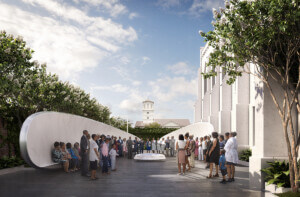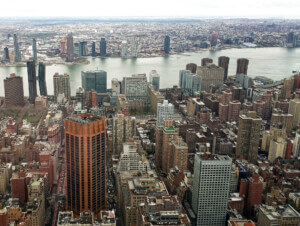Any visitor familiar with Lower Manhattan’s tangle of administrative, federal, and civic buildings at the boundary of Tribeca and Chinatown has certainly passed the African Burial Ground National Monument. The 6.6-acre National Register of Historic Places-listed site is thought to hold the remains of “15,000 free and enslaved Africans” buried between the 1690s and 1790s, according to the National Park Service.
The historic mass grave was marked with a slightly sunken memorial from architect Rodney Leon in 2007 and a visitor’s center in 2010, but now Senate and House Democrats are reintroducing an attempt to build a full museum at the site.
On April 1, U.S. Senator Kirsten Gillibrand (D-NY) and Congressman Jerrold Nadler (D-NY) held a press conference at the site to announce the reintroduction of the African Burial Ground International Memorial Museum and Educational Center Act. The 2017 proposal was unsuccessful under the Trump administration, but with Democrats in control of the House, Senate, and White House, it’s hoped a future memorial museum would be a companion to the National Museum of African American History and Culture in Washington, D.C.
“We cannot fight for equality without understanding the history of slavery in this country,” said Congressman Nadler, who plans on introducing the bill in the House of Representatives. “The development of a shared history is not spontaneous… it is time we put in intent behind the effort to guide and tell the stories here.”
Nadler added that the “international” part of the bill’s name is in reference to the worldwide slave trade that supplied humans to the United States in colonial times, and that unfortunately still exists the world over today (albeit in a greatly diminished form).
The text of the bill notes that a museum had been suggested for the site in 1992 by a federal steering committee and that the authorization of the National Museum of African American History and Culture “identified the period of slavery as one of the periods of the African-American diaspora that would be encompassed by the museum”—thus, linking the two institutions is something of a no-brainer.
According to Senator Gillibrand, the Burial Ground museum would display materials and exhibitions complementary to its D.C. counterpart, as well as shows from historically Black colleges and universities (HCBU) and similarly aligned museums.
The reintroduction of the bill comes at a watershed moment for new national museums, as only five months ago the future Smithsonian-run National Museum of the American Latino and the Women’s National History Museum were both signed into existence as part of a $2.3 trillion omnibus spending bill in December of 2020.
The African Burial Ground National Monument site was first discovered in 1991 during excavation for an adjacent federal building (the memorial is slotted at the corner of a tower holding offices for the U.S. Treasury Department, IRS, EPA, and several New York City agencies). According to the National Park Service, “the site revealed the remains of 419 Africans and over 500 individual artifacts. Considered one of the most important archeological finds of the 20th century, the African Burial Ground is of national significance because of what it can tell us about the lives of Africans and African Americans in an urban context. Both the deceased and their possessions help piece together a more complete history of New York City in the 17th and 18th centuries and what life was like for Africans in the city.” Due to the site’s archeological importance (still ongoing today), it was deemed a National Historic Landmark in 1993 and also listed on the National Register of Historic Places. It later became a National Landmark in 2006 and maintenance was accordingly turned over to the National Park Service.











